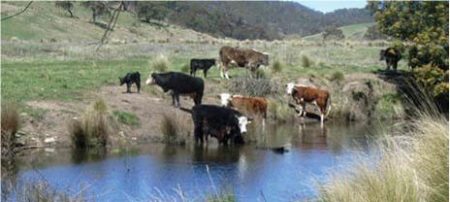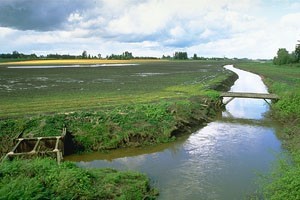By: Corey Serhan, University of Saskatchewan Student

Farmers and ranchers today are covering many acres with help from new technology. With new technologies coming into agriculture, the government and the public are becoming increasingly worried about their environmental impact and the land we farm. That is why policies and programs are beginning to be implemented so that farmers can produce high yielding crops year after year and help protect the environment at the same time. Some of these programs are the Environment Farm Plan (EFP) and Farm Stewardship Programs (FSP) which some may think of as being only for organic farming, but this is NOT the case. EFP is designed so that conventional farmers (along with GM growers) and ranchers can continue to produce strong crop yields to help feed the world’s population while maintaining the quality of soil, air or biodiversity resources. Some Beneficial Management Practices (BMP) include;
- funding caps for riparian area (land adjacent to the bank of a river or other body of water), grazing and fencing, protecting high risk erodible and saline soils, farmyard runoff to protect ground and surface water; and
- replacing and recycling used oil, and filters and safe storage of pesticides to reduce risk of environmental contamination

Within Saskatchewan, EFP is a self-assessment used to help farmers understand how their farm impacts their environment. With the EFP there are also provincial and federal FSPs which both provincial and federal governments have developed to help support producers protect our environment and make it more sustainable for years to come. With the help of FSP (programs that allow Saskatchewan producers access to financial aid to help add BMPs to one’s farm), farmers in Saskatchewan can receive direction for farm improvement and assistance to reduce costs and to help add environmental plans to their farms.
According to Stats Canada, in 2011 60% of Canadian farms did not have an EFP. To me, this is an easy fix because drastic changes are not likely needed to be made to one’s farm. It would be even easier if the government were willing to offer financial incentives to BMPs for your farm. An example of an environment plan farmers can take advantage of are the use of proper storage facilities for their chemicals. This is not only beneficial to the public and environment but also for those working on the farm. Little changes around a farm that seem so insignificant can go a long way if more and more farms can continue to make the small changes. The programs that are offered to farmers allow them to save huge amounts of money which can be saved or spend on farm growth, environmental planning, new equipment and so on. The funding through BMPs that can be given to farmers can vary anywhere from 20-60% depending on which program was chosen. An example of one BMP is the relocation if Livestock Confinement Facilities BMP which farmers can receive 60% of funding with a maximum cap at $60,000. Here can be found some different BMPs farmers can apply to in order to get help with funding.
Farmers and ranchers in Saskatchewan are very committed to environmental sustainability but do not know how to do so. The Government of Saskatchewan shows how easy it is by completing an EFP, then proving your purchase of EFP items and services by just submitting a claim. EFPs are useful tools that producers use to grow awareness about the environmental risks within their operations, and take a positive step for themselves and the environment they farm within. This is an important step to take for farmers to gain the public’s trust in agriculture. I believe all farmers should complete an EFP, and realize that they can add some BMPs to their farm which will have little cost to them. It is a huge benefit that farmers can do for their land which can help them thrive in years to come and with the added bonus of protecting our land and water resources.
[su_spoiler title=”References:” style=”fancy” anchor=”References”]
References
Government of Saskatchewan. (2017). Farm Stewardship Program. Government of Saskatchewan website. https://www.saskatchewan.ca/business/agriculture-natural-resources-and-industry/agribusiness-farmers-and-ranchers/growing-forward-2/environment-programs/farm-stewardship-program
Briere, K. (2015). Environmental farm programs enhanced. Western Producer. http://www.producer.com/2015/04/environmental-farm-programs-enhanced/
Government of Saskatchewan. (2017). Learn How Your Farming Practices Affect the Environment. Government of Saskatchewan website. http://www.saskatchewan.ca/business/agriculture-natural-resources-and-industry/agribusiness-farmers-and-ranchers/growing-forward-2/environment-programs/environmental-farm-plans
Statistics Canada. (2015). Environmental Farm Plan. Statistics Canada website. http://www.statcan.gc.ca/pub/21-023-x/2013001/part-partie1-eng.htm
Government of Saskatchewan. (2017). Pre-Approval Applications. Government of Saskatchewan website. https://www.saskatchewan.ca/business/agriculture-natural-resources-and-industry/agribusiness-farmers-and-ranchers/growing-forward-2/environment-programs/farm-stewardship-program/applying-to-the-farm-stewardship-program/pre-approval-applications
Agriview. (2015) Volume 11, Issue 2. Environmental Farm Plan now online. Page 13. Government of Saskatchewan.
[/su_spoiler]
 Hello, my name is Corey Serhan and I am currently in my 3rd year at the University of Saskatchewan where I study at the Agriculture and Bioresources College where I am pursuing a Bachelor of Science degree in Agribusiness with a minor in Field Crop Production. I grew up in Tisdale, Saskatchewan where agriculture has been a big part of my life and in my family since I can remember. When I finish my degree I hope to play a role in the agriculture world helping the industry grow.
Hello, my name is Corey Serhan and I am currently in my 3rd year at the University of Saskatchewan where I study at the Agriculture and Bioresources College where I am pursuing a Bachelor of Science degree in Agribusiness with a minor in Field Crop Production. I grew up in Tisdale, Saskatchewan where agriculture has been a big part of my life and in my family since I can remember. When I finish my degree I hope to play a role in the agriculture world helping the industry grow.

